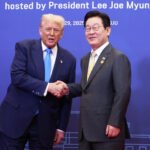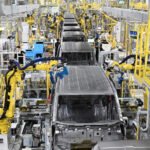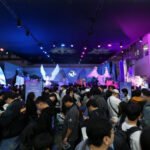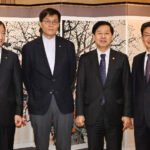Doosan Group headquarters in Bundang, Gyeonggi Province
Doosan Group’s announcement of a merger between Doosan Robotics Inc. and Doosan Bobcat Inc. has met with strong criticism from investors and politicians.
They argue the two companies’ combination would harm minority shareholder interests, calling for a revision to the Capital Markets Act to properly assess the valuations of companies to be merged.
On Sunday, the South Korean business group said that Doosan Robotics will merge with its Doosan Bobcat by early next year.
The move is aimed at freeing up the construction machinery maker from fair trade regulations that force Bobcat, as a sub-subsidiary of holding company Doosan Corp., to purchase 100% of a company it wants to buy and thus helping it take a leading role in chasing M&A targets.
Shareholder activists argued that their 1:1 merger ratio significantly inflated loss-making Robotics’ value, or sharply diminished the enterprise value of Bobcat, the group’s cash cow.
They blamed it on the current Capital Markets Act that stipulates a merger between listed companies needs to be based on their average share prices of the past month.
The Korean Corporate Governance Forum holds a seminar on July 22, 2024
Cheon Joonbum, vice chair of the Korean Corporate Governance Forum (KCGF), said that the law could be abused to help largest shareholders cement their control of companies through a merger or spin-off.
In a seminar hosted by the KCGF on Monday, he pointed out that in the Securities Prospectus submitted for the merger, Doosan foresaw a low growth possibility of the market of collaborative robots where Doosan Robotics specialize. But it failed to provide objective information needed to accurately measure Robotics’ current valuation.
The shareholder activist said that Doosan Enerbility Co., Bobcat and Robotics took no consideration of shareholder interests to be affected by their deals that involve a spin-off of Enerbility and share swap.
By inflating Robotics’ valuation, Doosan Corp., a majority shareholder of Robotics with a 68% stake, would increase its ownership of the merged entity between Robotics and Bobcat, Cheon claimed.
He urged the three Doosan Group units’ board of directors to re-examine the announced corporate restructuring.
BREACH OF TRUST
Kim Hyung-jung, a lawmaker of the opposition Democratic Party, said in the seminar that their merger could constitute a breach of trust because Bobcat’s enterprise value would not be properly reflected in their merger process.
She argued that if financial authorities approve of the merger, it would violate the financial authorities’ obligation to protect investors.
Kim Byung-hwa, a nominee for the Financial Services Commission, speaks during his confirmation hearing at National Assembly
The same day, Kim Byung-hwa, a nominee for the regulatory Financial Services Commission (FSC), said in his confirmation hearing that he was aware of market concerns about the proposed merger between Robotics and Bobcat and he will look into the matter in regards to whether there is any area to be addressed.
“I think companies should make efforts to communicate with shareholders first when pursuing this (kind of decision),” he said in response to a lawmaker’s claim that Doosan Group’s corporate reshuffling through the two units’ merger would harm minority investors’ interests.
To merge with Bobcat, Robotics will take full control of the affiliated company by taking over the latter’s stake held by Enerbility and securing the remainder in a tender offer. In return, Bobcat shares will be exchanged into those for Doosan Robotics.
“(Doosan Group) would not have been able to do this if the commercial law has a clause of duties and responsbilities of board of directors to consider the interests of all shareholders,” said Kim Kwang-joong, a lawyer at ClassHankyul, a law firm.
In 2023, Bobcat earned 1.39 trillion won ($1.0 billion) in operating profit and holds around 1.8 trillion won in cash and cash equivalents as of the end of March.
In contrast, Robotics have suffered losses over the past few years. Last year, it posted 19.1 billion won in losses.
By Haeyoung Park
bono@hankyung.com
Yeonhee Kim edited this article















